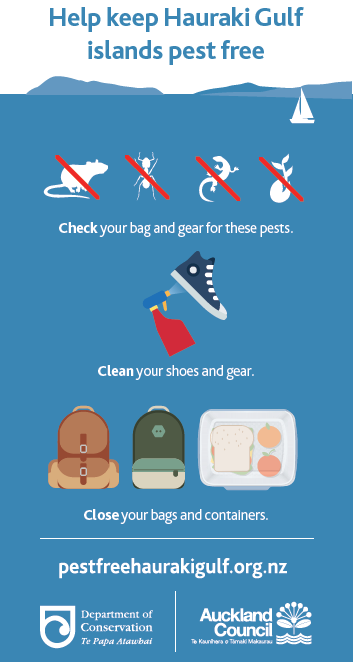Tīkapa Moana o Hauraki/The Hauraki Gulf and its islands are home to rare and endangered animals, such as the black petrel, tūturiwhatu/NZ dotterel, oi/grey-faced petrel, pāteke/brown teal and wetapunga/weta and chevron skinks. Some of these species are only found on the Hauraki Gulf Islands.
Living on and visiting the islands involves a responsibility to ensure all types of pests are not carried across in personal or commercial goods and cause harm to native wildlife.
It is important that we work together to ensure that the islands within the Hauraki Gulf are protected from pest species that could disrupt the natural flora and fauna that exists there.
We ask that all passengers check and clean their gear to be free of any pest species, dirt or soil before arriving at our terminals.
Risk goods:
Some transported goods have a higher chance of spreading pests within the Hauraki Gulf. Potting mix, aquariums and camping equipment are some examples of goods that you may be transporting that could have a pest on board.
These are considered ‘risk goods’ which means that extra care when loading or an inspection by a biosecurity advisor is encouraged before transportation.
Find out more about risk goods and what can be done to ensure pests are not transported.
Moving a building?
This includes prefabricated or flat-packed buildings and shipping containers, used as a building or for storage.
If you're moving a building into, or from one place to another within the Hauraki G
ulf Controlled Area, you need an inspection and an approval to ensure that no pests are being transport
ed.
10 working days' notice is required when booking an inspection. An approval must be issued before arriving at the terminal otherwise you can be refused travel.
Penalties exist if you are found to be carrying pests or don’t comply with these instructions.

Why do you need to check your gear?
The Hauraki Gulf is a nationally-significant marine park. Many of the islands of the Gulf are pest free, or partially pest free. This means they are now home to some of New Zealand’s rarest and most endangered species – eg tuatara, takahe, shore plover and kiwi. The islands are also recovering naturally as birds reintroduce themselves to these safe havens. It is important to keep them pest free – and we need your help!
Pest animals and plants can invade our islands by stowing away on or in your footwear, gear or boat. Rats can squeeze through a 12 mm gap and mice can squeeze through a 7 mm gap. Insects could hide in your bag, and weeds, seeds and soil could cling to your clothing and shoes.
Pests threaten New Zealand's native wildlife:
- Rats eat birds, eggs, reptiles and insects.
- Mice prey on insects and eat small birds and reptiles.
- Argentine ants can reach large numbers and have a big appetite killing our native insects, skinks, geckos and baby birds.
- Plague skinks compete with native lizards and other animals for food and habitat and have displaced our native skinks on the mainland.
- Soil can carry plant diseases such as kauri dieback.
- Weed seeds can become a weed forest and smother native plants
Pests threaten New Zealand's native wildlife:
- On the mainland: Get rid of the pest and clean your gear again.
- On the ferry: Tell the crew what you have found and where it is.
- On the island: Report sightings to the DOC conservation emergency hotline 0800 DOC HOT (0800 362 468).
Biosecurity
DOC Managed Islands: For Rangitoto, Motutapu, Motuihe, Kawau, Motuora and Tiritiri Matangi, please contact Colin Christie, Biodiversity Ranger - Auckland Inner Islands, at mobile 027 367 2420 or email [email protected].
Check with the Department of Conservation (DOC) about any restrictions that apply to visiting or moving items to islands it manages.
All Other Islands: For advice or to arrange an inspection of Aotea, Rakino, Kawau ,Waiheke, etc., please email: [email protected].
To find out what requires a biosecurity inspection click here
Without your co-operation your trip may not be able to take place, so if you have any doubts or questions about biosecurity, please ask us.